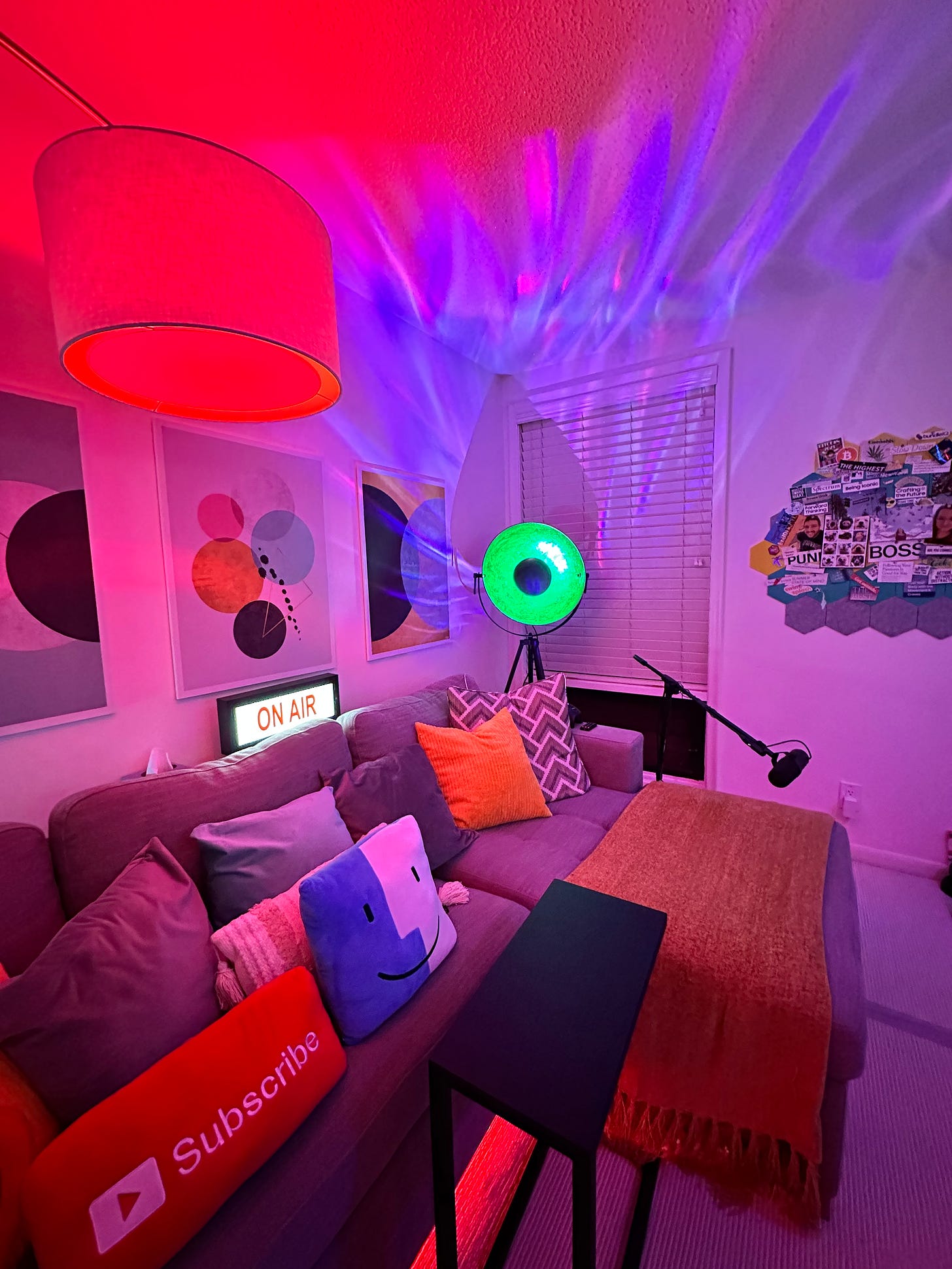On creating sensory room experiences

I’m here today to open your mind when it comes to designing your home. Let’s start with a basic question: is your home illuminated with white light? Have you ever considered what your home could be like with color LED lights instead? Instantly, your home would go from sterile and boring to lit and vibey. If you haven’t guessed already, vibes are important to me. I love the fact I can light up my office (and other parts of the house) with various light palettes of my choosing based on my mood and the vibe I want to create.
I’ve written extensively about my love for Philips Hue color LED lights, including how to create really cool light palettes, but today I want to dive deeper into how I’ve gone about creating the ultimate sensory experience in my office (and elsewhere around the house). It’s been a game changer in how I live and work.
Creating a sensory room experience
There are a few things I consider while building out a sensory room. The first is always the lighting. White light is harsh, it’s not fun, and it’s always the same – sometimes you can’t even dim your lights. The horror! This is why I love the Philips Hue color LED lights – they’re a little pricey but worth it. I’ve had all of mine for around 3-4 years at this point and to be honest, there’s no way I could go back to anything else. Which is exactly why I’m slowly replacing all the lights in my house.
Now that you’ve got your Philips Hue lights, the next thing I consider is what other lighting accessories I can buy to enhance the experience of being in the space. This ranges from the lamps for the lights to additional types of lighting such as a galaxy projector.

I would also recommend thinking about sounds within the room. Consider a good pair of speakers – they can make all the difference when it comes to creating an immersive experience.
Aside from using technology to create sensory experiences in your room, you should also look at art and textures (e.g. a fuzzy chair). Obviously, the right art in a space can really bring it together but paired with good lighting it can change your experience when looking at the piece. That’s exactly the case for me, I have a piece of art – it’s a colorful acrylic painting of John Lennon, and when I adjust the hi-hat light above the painting, it’s a completely different vibe. I can stare at it for hours.
Another big tip of mine when building out a sensory room is: color is good. I repeat: color is good! Don’t be afraid of color! Embrace it! And please, please make it fun!
Why create a sensory room experience?
That’s a good question to ask, especially because it seems like something that is a high-effort, luxury item. I’ll tell you why setting up a sensory room isn’t as hard as you think — and is totally worth it!
Match mood / vibe – A good sensory room should be able to match your mood and vibe. Think of it as an extension of how you currently feel. It should feel good in your room when you’re sitting or standing in it. Ideally, the lighting should feel like part of the room, not just something that allows you to see in the room.
Soothing effect / de-stressing – Sensory rooms are great for de-stressing. Between your lighting options, sounds, and textures (e.g. silky soft blanket) you can create a nice little space where you can find calm and comfort.
Colors are cheery – I think seeing color – especially bright colors – daily, makes me happier. I can’t promise the same will be for you, but it’s certainly a possible plus.
Shots of my office / sensory room.
Products for sensory room experiences
Here are some of the products I have in my office / sensory room that I can highly recommend:
- Philips Hue starter kit – $173
- Rosetta Galaxy projector – $40
- Weave Greige floor lamp – $229
- Fresno swivel chair – $1,899 (I actually have a different chair, but they don’t sell it anymore. This one is somewhat similar.)
- KEF LS50 Wireless II – $2,799 (I have the original KEF LS50 Wireless speakers. This is the newer version.)
- Weighted blanket – $31
Time to get started
Hopefully by now you’re at least curious about creating a sensory room in your home – or maybe even throughout your home! You now have a good place to start. And don’t be overwhelmed by all of this — we did my space over the course of 2.5 years. See how the space looked before we [slowly] turned it into a sensory experience.
Before and after. Same exact room!
If you have any questions about creating sensory rooms (or PR/strategy/marketing), please don’t hesitate to reach out!
A(i) bonus
I created some AI generated art with Midjourney to dream up what a really dope sensory room could look. Take a look — curious which you think is better: AI or mine?
AI generated sensory rooms in Midjourney.